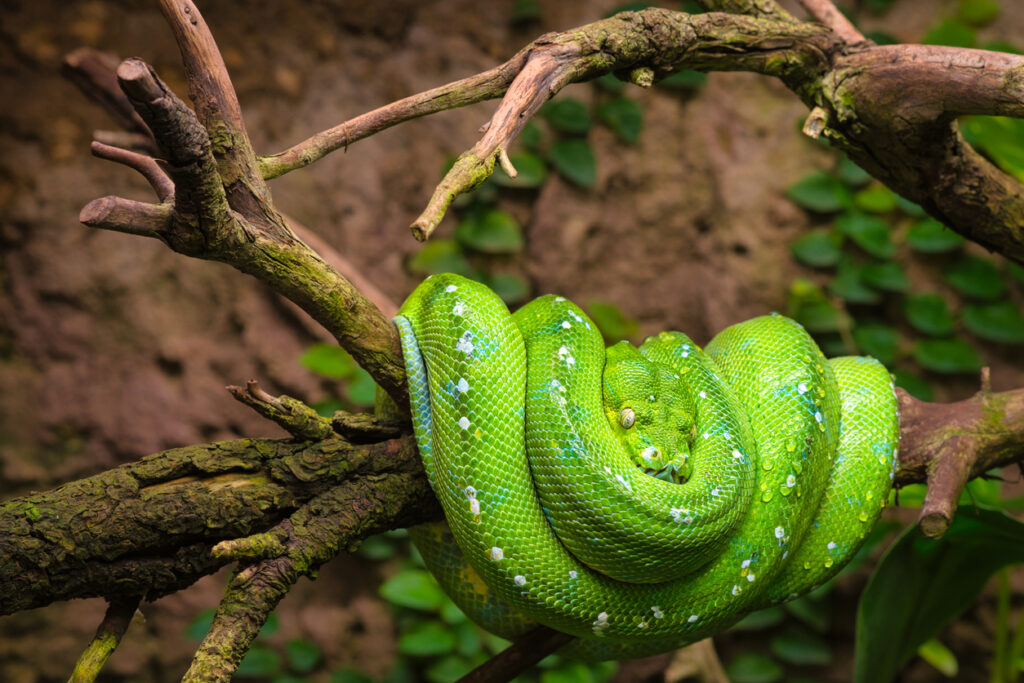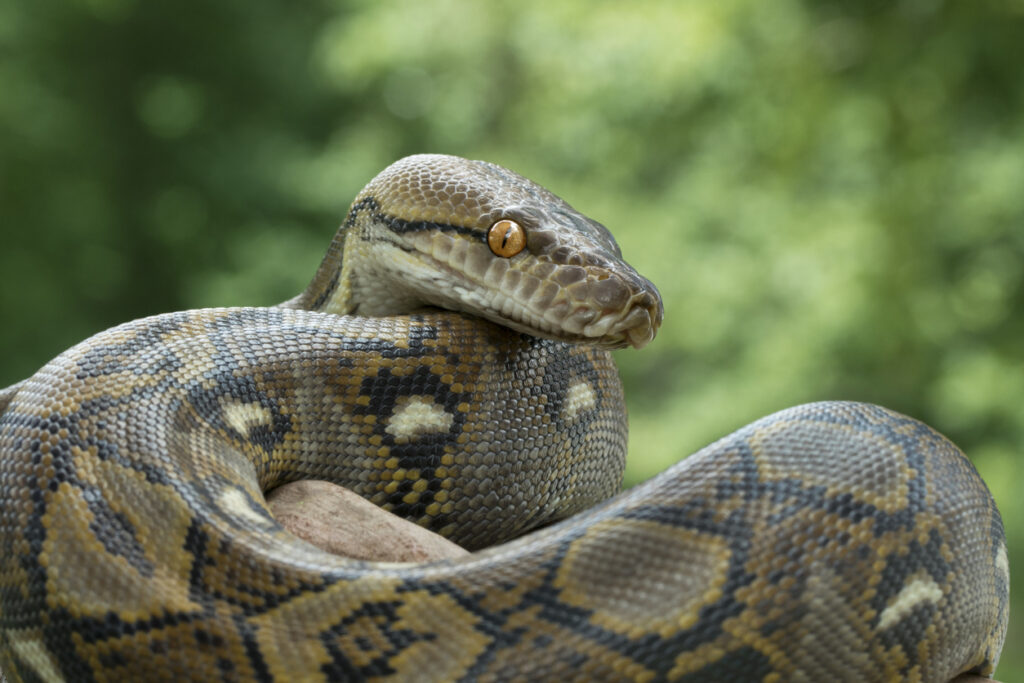Of all the snake species in the world, few attract as much curiosity and intrigue as the python. These beautiful cold-blooded creatures are beloved for their vibrant colours, impressive size and inquisitive nature, attributes which make them wonderful additions to aquariums all around the world – including right here in Hastings.
That’s right, our Jungle Room plays host to a handful of pythons, including royal pythons and green tree pythons. As you’d expect, they’re incredibly popular here at Hastings Aquarium, so we thought we’d help you get to know them a little better before your visit with these 22 need-to-know python facts.
1 – Royal pythons can live until they’re over 40 years old! The oldest royal python ever identified lived until the grand old age of 47
2- Green tree pythons wiggle their tales to attract their prey, striking when the unfortunate critters wander too close.
3 –Royal pythons are also known as ‘ball’ pythons because of the ball-shaped defensive posture they exhibit when predators are close by. They tuck their head beneath their bodies and coil up into a perfectly spherical shape – like a scaly football!
4 – All pythons are classified as constrictors, meaning that they constrict their prey rather than injecting it with venom. To do this, they wrap one or two coils around their prey before constricting, monitoring the animal’s heartbeat to make sure it’s dead. A grisly end to be sure, but an amazing feat of animal evolution and survival.
5 – Green tree pythons have more than 100 teeth – that’s three times more than we have!
6 – The name ‘royal python’ stems from the fact that African rulers once wore live pythons as jewellery. Now that’s one way to make a statement!

7 – There are 41 species of pythons, making them one of the largest and most diverse snake families in the world.
8 – Royal pythons are generally found in the open savannahs of West-Central Africa, but can also live in drier tropical rainforests. They’re identified by their dark-brown skin which is usually covered by beige blotches.
9 – The reticulated python is the longest snake in the world and can reach up to 10 metres in length, weighing in at over 113 kg – that’s almost double the average person!
10 – Green tree pythons can reach five feet in length, which is about 1.5 metres. These non-venomous snakes are native to tropical rainforests and are most commonly found in Indonesia, New Guinea, and forested parts of Australia.
11 – The smallest python is the pygmy python, which grows to a maximum length of around 50 cm – 9.5 metres smaller than its cousin the reticulated.
12 – Green tree pythons live in trees while royal pythons live in burrows. Both rely on camouflage to catch their prey, hence why one is green, and one is brown.
13 – Pythons can be both nocturnal (active at night) and diurnal (active during the day). It all depends on where they live and how hot the conditions are.
14 – Some pythons typically lay up to 100 eggs in a single ‘clutch’ . Like most snakes, they play no real role in helping to raise their young, which are left to fend for themselves from birth.
15 – In the wild, pythons do have some natural predators, including mongooses, raccoons, and large birds of prey. Of course, this does depend on the size of the snake – not many animals would be stupid enough to mess with a reticulated python, for example.
16 – All pythons are what’s called ‘ambush predators’. That means they don’t proactively stalk their prey, but instead hide and wait for prey to come to them.

17 – The largest species of pythons have been known to eat crocodiles, deer and pigs whole. Yikes!
18 – Pythons can survive in almost any warm habitat. From tropical rainforests to arid deserts – if it’s hot, you’ll probably find pythons there.
19 – Remarkably, pythons can hold onto tree branches with their tales to reach other objects. It’s an impressive sight, with the snake’s strong, rigid body allowing it to defy gravity to move seamlessly through the trees.
20 – Pythons travel at an average speed of just 1 mph. That may not sound like much, but as pythons rely on stealth to catch prey and avoid predators, it’s important for them to stay as quiet as possible.
21 – To avoid suffocating while feeding, pythons can breathe with their mouths full. That’s thanks to a tube at the front of their mouths that acts a little like a scuba mask, allowing airflow even when they have a mouthful of rodent.
22 – The green tree python is often mistaken for the emerald tree boa, and it’s true that these snakes do look very similar. However, one way to tell them apart is that most boas give birth to live young, while pythons, like a lot of snakes, lay eggs.
So, there you have it, 22 facts about pythons that you may or may not know. Keen to find out more about these beautiful reptiles? Come meet our inhabitants at Hastings Aquarium, where our special ‘Jungle Encounter’ talk provides the perfect opportunity to get to know our pythons a little better. Click here for our opening times and visitor info.
